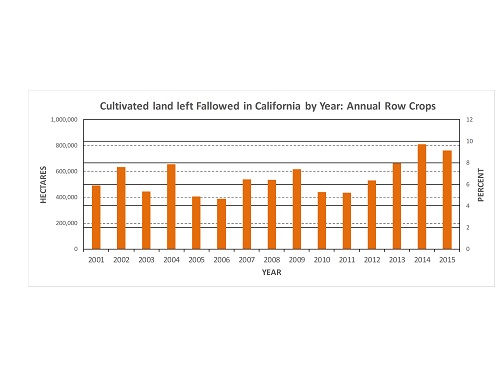One measure of a society’s security is access to food, which is produced by a functioning, viable agricultural system that has access to sufficient water. An important metric to monitor for characterizing agricultural system viability and optimizing water use in agricultural areas is the amount of cropland left fallowed or unplanted. Fallowed croplands are difficult to model from remotely sensed data because they have many expressions; for example, they can be managed and remain free of vegetation or be abandoned and become weedy.
USGS researchers have developed an algorithm that can be used to routinely map cropland status (planted or fallowed) with over 75% user’s and producer’s accuracies using 250-m, 8-day composite Moderate Resolution Imaging Spectroradiometer (MODIS) normalized difference vegetation index (NDVI) data. The Fallow-land Algorithm based on Neighborhood and Temporal Anomalies (FANTA) compares the current greenness of a cultivated pixel to its historical greenness and to the greenness of all cultivated pixels within a defined spatial neighborhood, and thus is transportable across space and through time. FANTA is currently being calculated for the entire conterminous United States.
The research is part of the Department’s (DOI) WaterSMART (Sustain and Manage America’s Resources for Tomorrow) Program, an interdisciplinary and collaborative DOI initiative that is working to achieve a sustainable water strategy to meet the Nation’s water needs. Timely and accurate knowledge of the extent of fallowing can provide decision makers with insights and knowledge to mitigate the impacts of drought and provide a scientific basis for effective management response.

Examples of field sites visited. Top row (L to R): (a) abandoned walnut, (b) abandoned pomegranate, (c) irrigated corn. Bottom row (L to R): (d) newly planted almond, (e) fallowed field with weeds, (f) fallowed field barren. Photo Credit: Brett Goble, citizen scientist.

Percent of annual row crop (non-perennial) cultivated land left fallowed in California by year. 1 percent ~ 80,000 hectares.
http://dx.doi.org/10.1080/15481603.2017.1290913
http://www.usgs.gov/climate_landuse/lcs/projects/wsmartmap.asp

